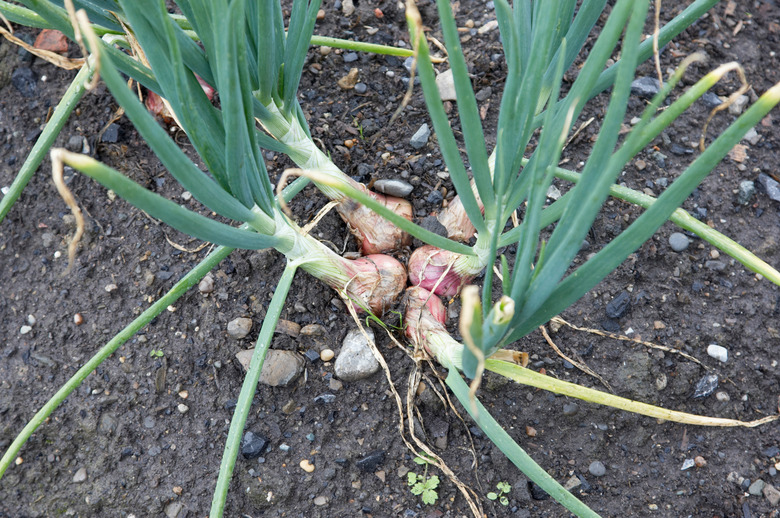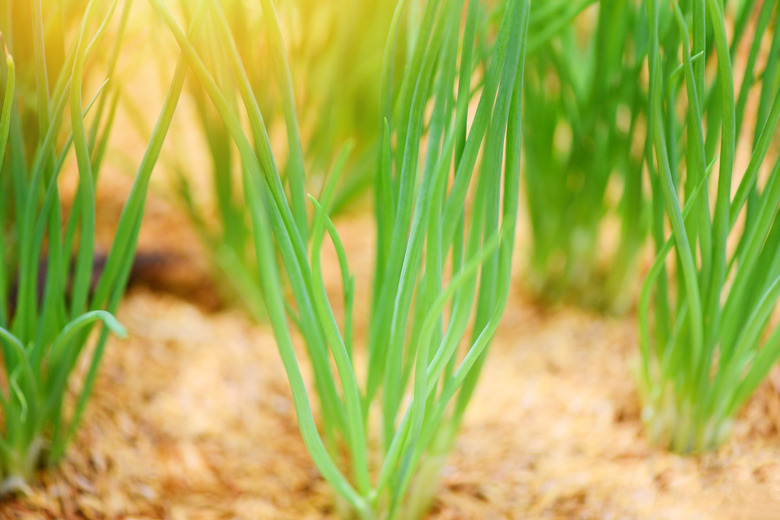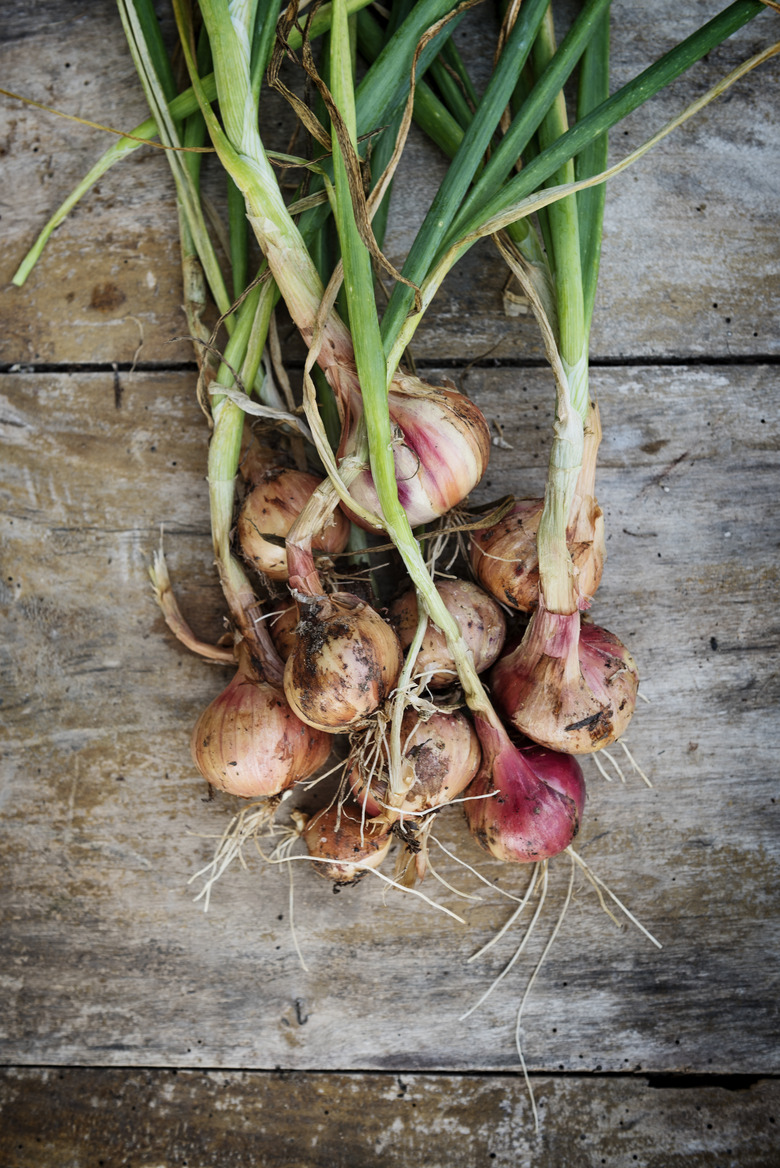How To Grow Shallots
We may receive a commission on purchases made from links.
If you like onions and garlic, you'll love shallots (Allium cepa var. aggregatum syn. Allium ascalonicum) because they taste a little like both, although their delicate onion flavor can be enjoyed raw. Likely originating in central or southeast Asia before being introduced to Europe during the Crusades, shallots have since been an integral part of European (especially French) cuisine and are sometimes known as eschallots, French shallots, potato onions or multiplier onions because one bulb can produce several more growing together in clusters. As a member of the amaryllis plant family (Amaryllidaceae), shallots can be pricey if you buy them at the grocery store, and that's an incentive to plant them in your home garden, especially given the fact that they are very easy to grow.
Where Do Shallots Grow Best?
Where Do Shallots Grow Best?
As annuals, shallots grow as far north as USDA hardiness zone 2 and as far south as zone 10, but it grows as a biennial in zones 5 through 10. The plant does very well in northern climates with freezing temperatures because the bulb has a dormant period during the winter during which it collects the energy to sprout with full vigor after the last frost. However, in the far North, the growing season may be too short to allow the bulbs, which are the best part of the plant, to fully develop.
In the most southerly climates, a fall planting is also recommended, but because the ground doesn't freeze over, the leaves will sprout and can be harvested like scallions or leeks during the winter. It's important to note that if you harvest the leaves, you're also removing the means of photosynthesis, and the shallots below ground may not properly develop.
When Should You Plant Shallots?
When Should You Plant Shallots?
Folk wisdom has it that you should plant shallots on the shortest day of the year and harvest them on the longest day, and while that probably isn't true everywhere, it's generally true that the bulbs benefit from a late-fall planting, particularly in warmer climates. As long as the roots have time to get established before the winter dormant period, the shoots will emerge in early spring, and soon after, you can begin enjoying the young leaves, which are basically green onions. Just be sure to leave some of the leaves on the plant to allow the bulbs to continue growing.
The shallot plant is a biennial in southerly locations, where it overwinters and flowers the following year. In more northerly locations, it's generally grown as an annual, which is usually harvested in the middle or end of the first growing season. Shallots are cold tolerant and are often planted in late fall in warm climates to give the roots time to get established during the winter months before producing a crop in early summer or midsummer.
In more southerly climates, you can plant the bulbs in midwinter as long as the ground is loose and hasn't frozen. The latest you should plant them is March or April before the ground warms.
Propagating Shallots from Sets
Propagating Shallots from Sets
On first look, it's easy to mistake a shallot for a small, elongated onion. The bulb has a copper, reddish or grayish paper-like skin, and the tubular leaves — which you can also eat — can be as long as 18 inches. When you cut the bulb in half, you won't find rings as you would if you cut an onion; you'll find garlic-like cloves. Small shallots may have two or three of these cloves, which are flat on one side and rounded on the other, while larger ones can have as many as six.
Shallot sets are basically the cloves, which are the small immature bulbs that have been obtained from plants, dried and stored. You can easily grow new plants from existing ones by separating one or two cloves from your freshly harvested plants or grocery store shallots and replanting them to keep the cycle going and maximize your investment in the shallot bulbs you purchased. Just don't replant in the same place where you planted the previous crop because the soil will be depleted of nutrients, and it may also harbor disease organisms. Generally, you want to wait at least three years before planting any member of the same plant family in the same place.
Starting Shallots from Sets
Starting Shallots from Sets
The most common way to plant shallots is to purchase shallot sets, which consist of several small bulbs, and plant each bulb 1 inch deep and separated from other bulbs by 6 to 8 inches. The bulbs are elongated, and the top, which is the tapered part, goes up, while the bottom, which is rounded and may already have root vestiges, goes down.
It's best to prepare the soil for shallots a few weeks before you plant them by turning in compost or organic matter and loosening the soil to make it loamy. Shallots need a well-drained soil; if your garden bed is heavy clay, consider installing raised beds lined with hardware cloth. Test the soil and add lime if it's too acidic; the ideal pH for shallots is around 6.5. Fertilize the rows with 5-5-5 fertilizer (or an organic equivalent) at a concentration of 1 pound per 10 feet, and if you plant in the fall, cover the shallot bulbs with 6 inches of hay or straw mulch to protect them from freezing temperatures.
Shallots like well-draining soil and full sun, but since they are cold tolerant, you can grow them in an outdoor container or a part of the garden that would also make a good place for a late-season crop, such as beets, carrots or cabbage. Start the shallots just before the ground freezes over in winter, harvest them in midsummer and then do your fall plantings. Chamomile, mint, sage and thyme are good companion plants and can occupy the same garden space concurrently or consecutively.
Starting Shallots From Seed
Starting Shallots From Seed
You can collect seeds from the flowers of heirloom plants and direct-seed your next shallot crop, although this method is a little more troublesome and is not as reliable as planting bulbs. Seeds will keep up to a year if you store them in a cool, dry place.
Your shallots will have to grow into the second year so you can collect seeds from the flowers. If you're growing a hybrid cultivar, however, the seeds produce unpredictable results by not growing true to type or even germinating at all. Grow heirloom shallots if you want to save seeds from year to year.
Direct-sow in the garden or containers, placing them 1/2 inch deep in loose, well-draining soil. If you space the seeds closely — 1/2 to 1 inch apart in rows separated by 10 to 18 inches — each plant will produce a single bulb, but you'll probably want the plants to produce multiple bulbs, in which case you should increase the spacing to 6 to 8 inches. Seeds germinate in four to five days when the soil temperature is between 45 and 90 degrees Fahrenheit, so they should be planted a few weeks before the fall frost so the roots have time to develop before the freeze sets in.
Caring for Shallots
Caring for Shallots
Shallots like to be in full sun, but if you can't manage that, they will tolerate some shade. They need water at the rate of 1 inch per week, so if you don't get enough rainfall, monitor the soil and water it before it dries. The soil should be kept moist to a depth of 6 inches; add a layer of mulch around the plants, pulling it 3 to 4 inches away from the leaves. Pull weeds as soon as they appear because if they're allowed to grow, they'll compete for nutrients, and the shallot bulbs won't reach their full potential.
How to Harvest Shallots
How to Harvest Shallots
If you plant shallots in the fall, the shoots will begin to emerge in the early spring, and at that point, you should brush away the winter mulch cover so the bulbs don't rot. Shoots can be harvested as green onions when they are 1/4 inch in diameter but don't forget to leave some to keep the bulb alive. When the remaining leaves start to turn brown and fall over, the bulb is ready for harvesting. This generally occurs in mid to late summer, depending on when you planted the bulbs.
You harvest the bulbs by lifting them, which basically means digging them out of the ground. Lifting should occur as soon as possible after the shoots turn brown, or the bulbs will enter a new growth cycle and will shrink in size. Reduce watering a week or so before harvesting to allow the bulbs to grow a protective skin and to prevent them from rotting in the ground.
After lifting the shallots, place them outside in a dry, shady, ventilated spot on chicken wire or hardware cloth and let them cure for a couple of weeks to increase their shelf life. They will keep for a month or two after harvest in a cool, dry place, so you can store the ones you don't use immediately in mesh bags. You can store them even longer if you first cure them for a month outside on a length of chicken wire or hardware cloth.
Using Shallots in the Kitchen
Using Shallots in the Kitchen
No one would consider shallots a decorative plant, although it is a good candidate for edible landscaping and could potentially be used as a border plant. Most people plant shallots to avoid having to buy them.
Use shallots like you'd use an onion or leek. The green leaves can be chopped and used fresh in salads, as a garnish or cooked into hot dishes. Dice or slice the bulbs and sauté in butter or olive oil for casseroles, quiches, soups, stews and any other dish that you'd normally use onions for flavoring.
Monitoring for Pests and Other Problems
Monitoring for Pests and Other Problems
Like onions, shallots are attractive to a few pests, and gophers are one of the most troublesome. If you didn't exclude the gophers by growing the shallots in containers or surrounding the garden bed with gopher wire or hardware cloth, there may be little you can do to prevent them from pulling the plants underground before your very eyes. If gophers and other burrowing animals are a persistent problem in your garden, consider consulting with a pest control expert to discuss exclusion or control strategies.
Onion fly larvae will burrow into the bulbs and ruin them. The flies emerge as adults in the spring and can fly about a mile in search of a nesting place. When they find one, they deposit their eggs near the base of the stem, and the emerging maggots burrow into the soil. The problem probably won't occur if the common roadside weed yellow rocket is growing nearby because the flies prefer it, but if not, plant carrots to attract the flies.
Onion thrips mostly affect the leaves and can render them unappetizing. Control strategies include deploying sticky paper and spraying with a garden-safe insecticide product.
Diagnosing Common Diseases
Diagnosing Common Diseases
Shallots are vulnerable to a small number of bacterial and fungal diseases. One of the most common fungal diseases is pink root, which turns the bulbs pink and then progressively darker until they shrivel and die. White rot is another problematic fungus that causes the leaves to die and the shallot bulbs to rot in storage.
Purple blotch and downy mildew are two other fungal infections that primarily affect the leaves. You can treat these leaf infections with a fungicide, but fungus that lives in the soil will continue to persist for several seasons. This is probably the most important reason you shouldn't plant shallots or any other member of the onion family in the same place for at least three years.


